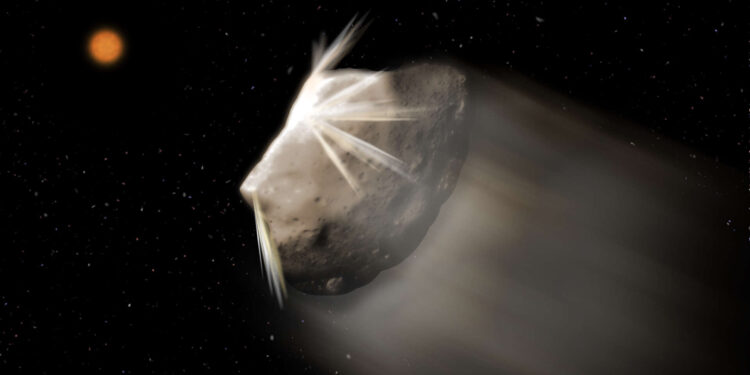Objects that look like asteroids can nevertheless become active for many reasons. These items are known as Centaurs and can have activity points and generate tails. Credit: Pamela L Gay/PSI.
Rapid reshaping of orbits resulting from a close encounter with Jupiter or Saturn can cause the Centaurs to exhibit comet-like activity, according to a paper by Eva Lilly, a senior scientist at the Planetary Science Institute.
Centaurs are small bodies similar to asteroids in size but comets in composition that orbit the sun in the outer solar system, primarily between the orbits of Jupiter and Neptune.
“We have found answers to the long-standing mystery of why some Centaurs became active like comets while others appear as simple silent asteroids. No one knew why they behaved this way. any sense.
There was no correlation with size, color or even orbit types,” said Lilly, lead author of “Semi-major Axis Jumps as the Activity Trigger in Centaurs and High-Perihelion Jupiter Family Comets” which appears in the Letters from astrophysical journals. PSI scientists Kat Volk, Jordan Steckloff and Henry Hsieh are co-authors of the work.
“In our work, we studied the dynamic history of all known centaurs, active and inactive, and coupled our results with thermal modeling. We wanted to find some sort of common pattern among active centaurs that was missing in inactive bodies of the population. Mapping the dynamic history of the Centaurs is a tricky task: they orbit in the realm of giant planets, and their orbital evolution is governed by the chaotic influence of the giant’s gravitational pull,” Lilly said.
“We used a numerical integrator, a code capable of predicting the evolution of the orbit of a celestial body, but for Centaurs this can only be known for a short period of time, usually several hundred years , after which chaos makes predictions inaccurate. We discovered that all active Centaurs experienced a close encounter with Jupiter or Saturn and that this encounter caused a significant orbital change, which we call the “a-jump.”
“The a-jump is primarily a decrease in the semi-major axis of Centauri’s orbit while reshaping it from elliptical to more circular, lower perihelion orbits. This change is very rapid – on the order of several months, and the semi-major axis can decrease by several astronomical units,” Lilly said.
“The jump then effectively places the affected Centaurs in orbits where their surfaces can warm up for longer, and in this way the thermal wave can reach the ices within, which will then sublimate and effectively render the Centaur active . are icy by nature; they originate from the Kuiper Belt of small bodies beyond Neptune but spend most of their dynamic lives in remote regions of the solar system where the environment is too cold for water and the other ice creams sublimate.
“They’re actually stored in a freezer,” Lilly said. “A-jumps simply bring some of them closer to the sun, where it is hot enough for the ice to undergo phase transitions such as sublimation and turn Centauri into a comet. Our thermal model confirms this. Our results suggest that each Centaur by nature has the ability to become active, but it all depends on how its orbit evolves.”
Activity has been observed in only about 10% of Centaurs, and the reason is unclear until now. All comets in the Jupiter family are periodically active and behave mostly like ordinary comets.
“We suggest that A-jumps could therefore be a major trigger for cometary activity on the Centaurs and JFCs. Our results further imply that analyzes of recent dynamical histories could be used to identify objects that are currently active or Might Become Soon,” where we identified three of these Centaurs with recent jumps that should be considered high-priority targets for observational monitoring to look for activity,” Lilly said.
More information:
Eva Lilly et al, Semi-major axis jumps as a trigger for activity in centaurs and Jupiter-family comets at high perihelion, Letters from the astrophysical journal (2024). DOI: 10.3847/2041-8213/ad1606
Provided by the Planetary Science Institute
Quote: Centaurs gain comet-like characteristics through close encounters with Jupiter, Saturn (January 9, 2024) retrieved January 10, 2024 from
This document is subject to copyright. Apart from fair use for private study or research purposes, no part may be reproduced without written permission. The content is provided for information only.



